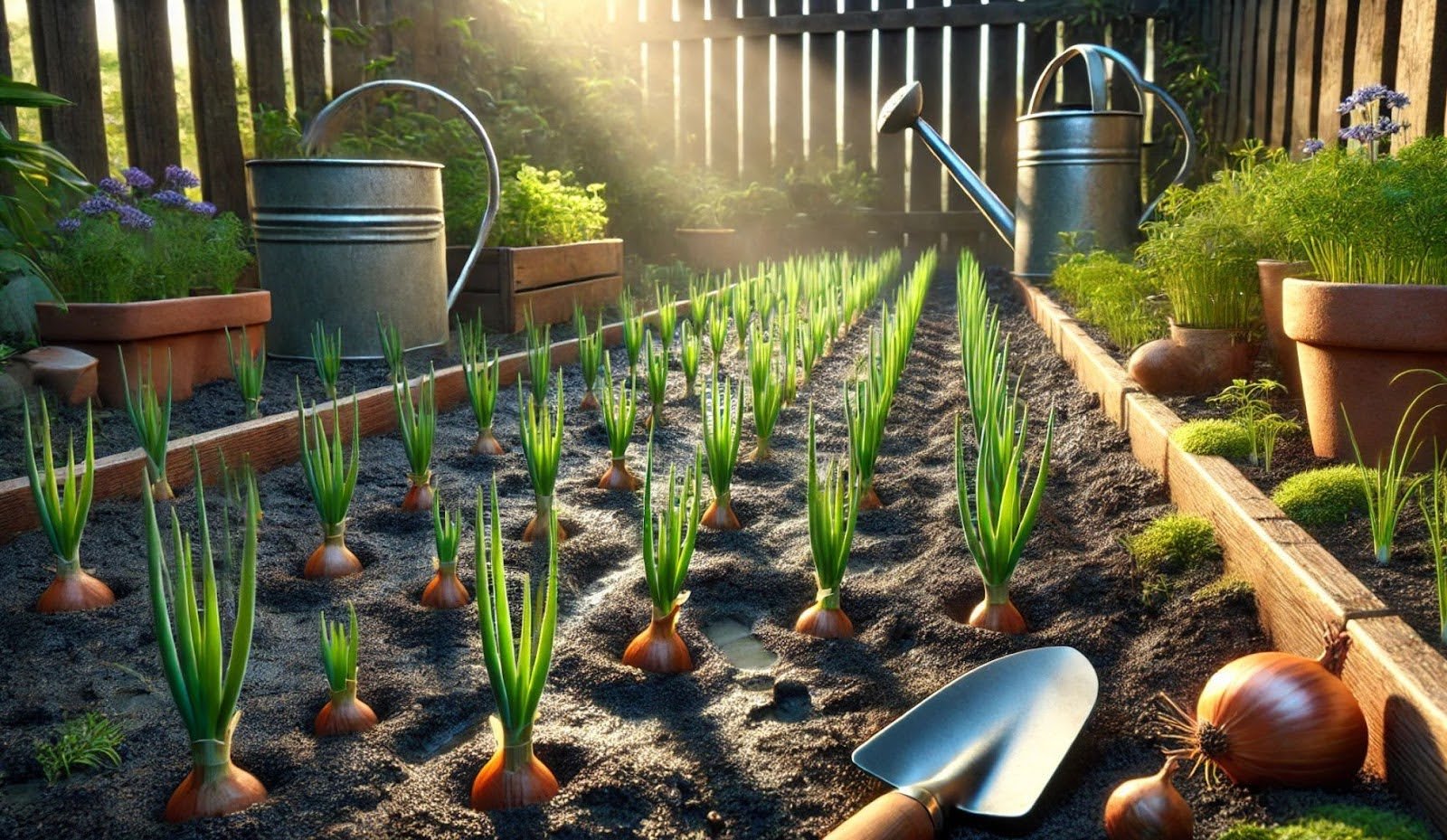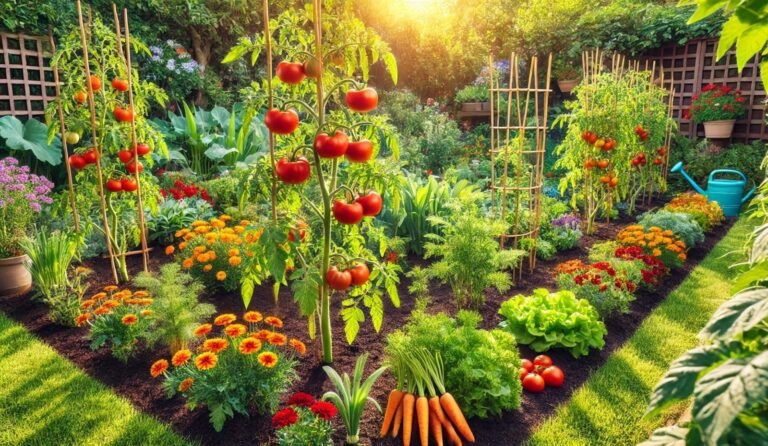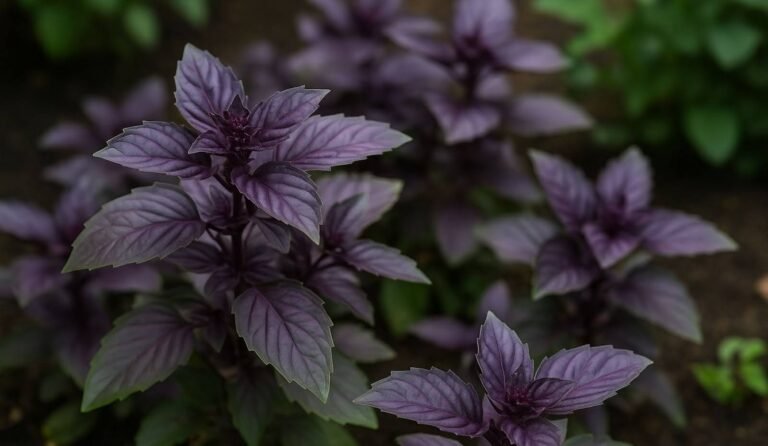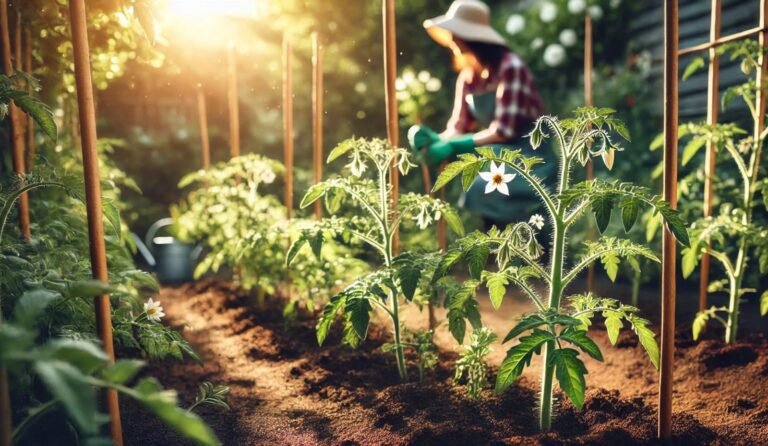When Do You Plant Onions in Your Zone? Easy Guide
When do you plant onions? It’s a question every home gardener asks eventually—and getting it right can mean the difference between a bumper crop and a bust. Whether you’re growing onions in a sprawling backyard garden or a couple of pots on your balcony, timing is everything. Plant them too early, and cold snaps might stunt them; too late, and you’ll miss the window for proper bulb growth.
But here’s the thing: onions aren’t as tricky as they seem. With a little understanding of your climate, the type of onions you’re growing, and some smart prep, you’ll be well on your way to growing your own flavorful harvest. Stick around, and we’ll walk you through exactly how—and when—to plant onions the right way.
Understanding Onion Varieties and Day-Length Sensitivity
Onions are categorized based on their response to daylight, which significantly influences bulb formation. Selecting the right variety for your region is essential to ensure healthy growth and a bountiful harvest.
Short-Day Onions
Short-day onions begin bulb formation when daylight reaches 10–12 hours. They are ideal for southern regions with mild winters, typically planted in the fall and harvested in late spring. Popular varieties include ‘Texas Early Grano’ and ‘Red Creole’.
Intermediate-Day Onions
Requiring 12–14 hours of daylight, intermediate-day onions are versatile and suitable for many regions. They are often planted in early spring and harvested in mid to late summer. Varieties like ‘Candy’ and ‘Red Candy Apple’ fall into this category.
Long-Day Onions
Long-day onions need 14–16 hours of daylight to bulb, making them best suited for northern areas. They are usually planted in early spring and harvested in mid to late summer. Examples include ‘Walla Walla’ and ‘Yellow Sweet Spanish’.
Selecting the appropriate variety for your region is crucial. For instance, planting long-day onions in the south may result in small bulbs, while short-day onions in the north might not bulb properly.
When to Plant Onions: Seeds, Sets, and Starts
When it comes to growing onions, timing isn’t just important—it’s everything. And that timing depends on how you’re planting them: from seeds, sets, or starts (also called transplants). Each method comes with its own advantages and ideal planting window, so it’s important to match your choice to both your climate and your schedule.
If you’re starting from seeds, you’ll want to begin indoors roughly 10 to 12 weeks before your region’s average last frost date. This gives your onion seedlings enough time to develop before being transplanted outdoors. It’s a slower method, but it’s cost-effective and offers the widest range of varieties to choose from. For gardeners in warmer climates, onion seeds can also be directly sown outdoors in late fall or winter for a spring harvest, especially if you’re planting short-day varieties.
Onion sets, which are small, dormant bulbs grown the previous season, are perfect for beginners and those looking for a quicker harvest. They’re easy to plant and don’t require the indoor prep time that seeds do. You’ll want to plant sets as soon as the soil is workable in early spring and the daytime temperatures are consistently above 50°F (10°C). Just push them gently into the soil, pointed end up, and keep them moist to encourage rooting.
Onion starts, or transplants, are young onion plants that have already been grown from seed and are ready to go into the ground. These are a great middle ground between seeds and sets—they offer variety like seeds, but without the long indoor growing process. Typically, you should start outdoors 4 to 6 weeks before your last frost date. They establish quickly and are usually more reliable than sets in producing large bulbs, especially in cooler climates.
Choosing between seeds, sets, and starts really comes down to how much time and effort you want to invest, and how soon you want to harvest. No matter which method you pick, aligning your planting time with the right onion variety and your local climate is the key to success.
When to Plant Onion Bulbs
Knowing when to plant onion bulbs—also referred to as onion sets—is key to growing strong, healthy onions with full, flavorful bulbs. The ideal time to plant them depends on your local climate, but generally, onion bulbs should be planted in early spring as soon as the soil is workable and no longer frozen.
In regions with mild winters, planting onions in the fall can lead to a strong, early harvest in late spring or early summer. Aim for soil temperature around 50°F (10°C) and be sure to place the bulbs with the pointed end up, just 1 to 2 inches deep in well-drained soil. Early planting gives the bulbs plenty of time to establish roots and grow before the heat of summer kicks in, which is essential for proper bulb development.
Onion Planting by Region
The best time to plant onions varies depending on your geographic location and climate, so tailoring your planting schedule to your region is essential for success. In southern regions (like USDA Zones 7–10), short-day onion varieties thrive and are typically planted in the fall or winter when temperatures are cooler but not freezing.
These onions take advantage of the mild winters and are ready for harvest by late spring. In contrast, northern regions (Zones 3–6) require long-day varieties that need longer daylight hours to bulb. These are best planted in early spring once the ground is workable and risk of hard frost has passed.
Gardeners in intermediate zones can opt for day-neutral onions, which aren’t as fussy about daylight and offer flexibility in both planting and harvesting. Knowing your USDA Hardiness Zone and understanding how it impacts onion growth is the first step in planting confidently and timing your crop just right.
How Far Apart Do You Plant Onions
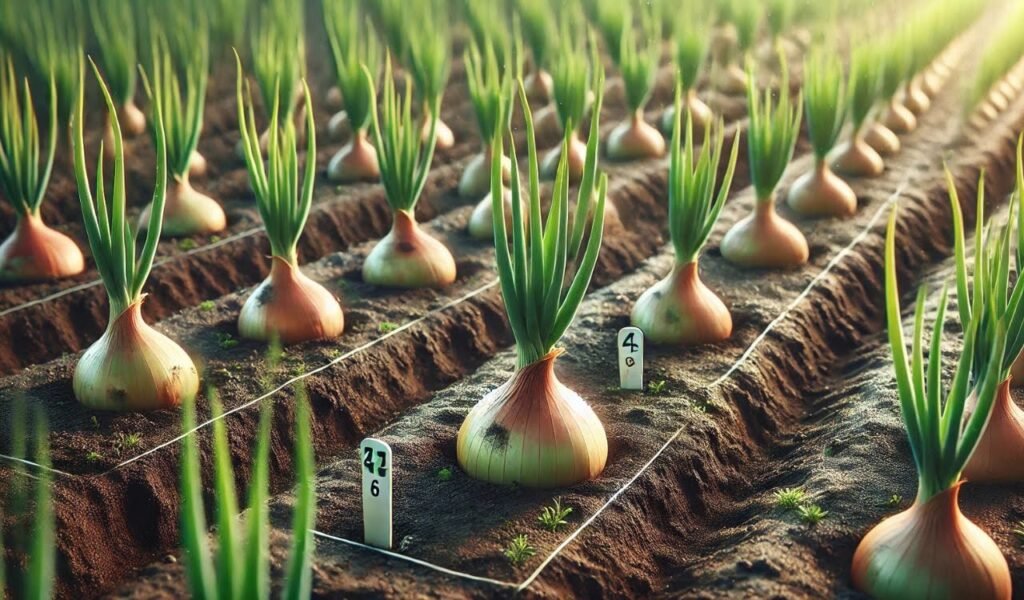
Getting the spacing right is a crucial step if you want your onions to grow into full, healthy bulbs. So, how far apart do you plant onions? It depends on the type of onion and your harvest goals. For full-sized bulb onions, plant them 4 to 6 inches apart in rows spaced about 12 to 18 inches apart.
This gives each plant enough room to expand underground without competing for nutrients. If you’re growing green onions or scallions, you can plant them closer together—around 1 to 2 inches apart—since they don’t require as much space to develop. Proper spacing not only promotes good air circulation, which helps prevent disease, but it also ensures your onions have the elbow room they need to grow big and flavorful.
How to Plant Onion Bulbs or Sets
Planting onion bulbs—commonly called sets—is a straightforward and beginner-friendly method that’s perfect for getting a jumpstart on the growing season. Start by selecting healthy, firm sets that are small in size, ideally no larger than a marble, as these tend to form better bulbs. Choose a sunny spot in your garden with well-draining, loose soil enriched with compost or organic matter.
Prepare the area by loosening the soil to a depth of 6 inches, removing rocks and clumps that could hinder bulb development. Place each onion set into the soil with the pointed end facing up, burying it about 1 to 2 inches deep. Space them 4 to 6 inches apart in rows that are 12 to 18 inches apart to allow for proper airflow and room to grow.
After planting, water thoroughly and keep the soil consistently moist—but not soggy—throughout the growing period. Within a few weeks, you’ll see green shoots emerging, and with a bit of patience and care, you’ll be well on your way to a harvest of flavorful, homegrown onions.
Indoor Onion Planting
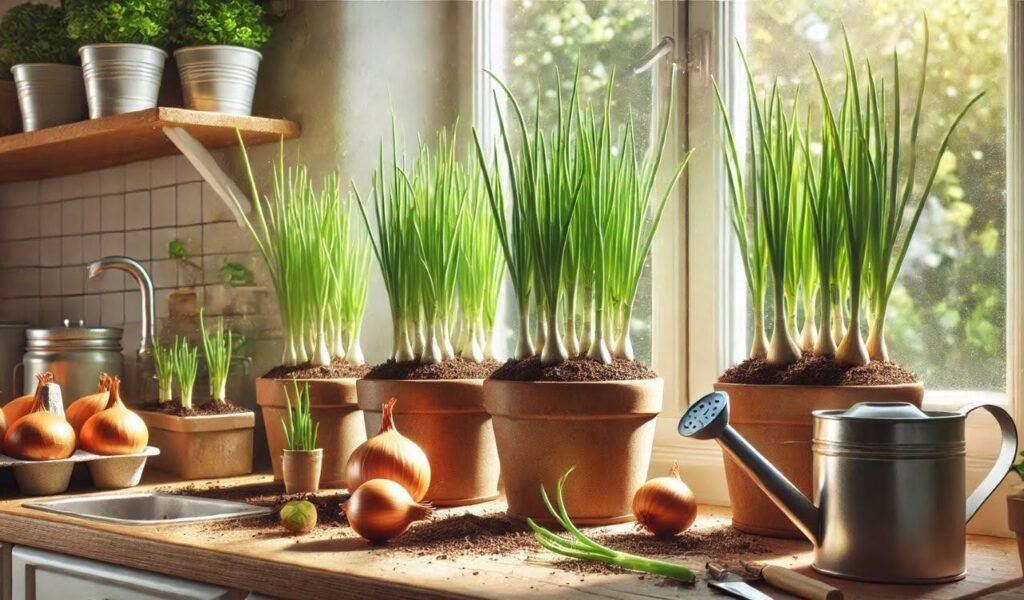
Growing onions indoors is a fantastic option for gardeners with limited outdoor space or those who want to enjoy fresh green onions year-round. The key to successful indoor onion planting is choosing the right containers—pots should be at least 6 inches deep and have good drainage holes to prevent soggy soil. Use a loose, well-draining potting mix enriched with compost to provide essential nutrients.
Place your containers in a spot that gets at least 6 hours of direct sunlight each day, like a sunny windowsill, or supplement with grow lights if natural light is limited. Water consistently to keep the soil moist but not waterlogged, and trim green tops as they grow for use in cooking. Whether you’re growing from seeds or sets, onions adapt well to containers and can thrive indoors with just a bit of care and attention.
Caring for Your Onion Plants
Proper care is essential for healthy onion growth.
Watering: Onions have shallow roots and require consistent moisture. Aim for 1 inch of water per week, adjusting based on rainfall and soil conditions.
Fertilization: Apply a balanced fertilizer at planting and side-dress with nitrogen-rich fertilizer every few weeks until bulbs begin to form.
Weed Control: Keep the area around onions free of weeds, which can compete for nutrients and water. Mulching can help suppress weed growth and retain soil moisture.
Pest and Disease Management: Monitor for common issues such as onion maggots, thrips, and fungal diseases. Implement crop rotation and proper spacing to reduce disease risk.
Harvesting and Storage
Onions are ready for harvest when the tops begin to yellow and fall over. Gently lift the bulbs from the soil and allow them to cure in a warm, dry, and well-ventilated area for 2–3 weeks. Once the outer skins are papery and the necks are dry, trim the tops and roots. Store cured onions in a cool, dry place with good air circulation.
FAQ
When do you plant onions?
You should plant onions in early spring or late fall, depending on your climate and the onion variety.
What month do you plant onion sets?
In most regions, onion sets are planted between March and April, as soon as the soil can be worked.
Can I plant onions in the fall?
Yes, especially in warmer climates—fall planting works well for short-day onion varieties.
How deep do you plant onion bulbs?
Plant onion bulbs 1 to 2 inches deep with the pointed end facing up.
How far apart should onions be planted?
Space onions 4 to 6 inches apart for full bulbs, and 1 to 2 inches apart for green onions.
Do onions grow better in sun or shade?
Onions grow best in full sun—at least 6 hours of direct sunlight daily.
Final Thoughts
When do you plant onions? It’s the question that anchors every successful onion-growing journey. Whether you’re using seeds, sets, or transplants, timing truly makes all the difference. Matching your planting schedule with your region’s climate and daylight hours ensures your onions have the best chance to thrive.
From indoor containers to backyard beds, these hardy veggies can grow just about anywhere with the right prep and care. Onions might be low-maintenance, but they reward thoughtful planning with big, flavorful results. So get your timing right, and you’ll be slicing into homegrown onions before you know it.

